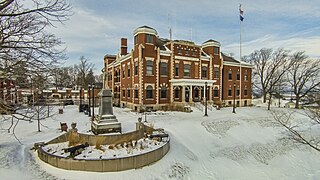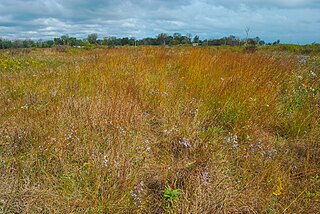
Kewaunee County is a county located in the U.S. state of Wisconsin. As of the 2020 census, the population was 20,563. Its county seat is Kewaunee. The county was created in 1852 and organized in 1859. Its Menominee name is Kewāneh, an archaic name for a species of duck. Kewaunee County is part of the Green Bay, WI Metropolitan Statistical Area as well as the Green Bay-Shawano, WI Combined Statistical Area.

Door County is the easternmost county in the U.S. state of Wisconsin. As of the 2020 census, the population was 30,066. Its county seat is Sturgeon Bay. It is named after the strait between the Door Peninsula and Washington Island. The dangerous passage, known as Death's Door, contains shipwrecks and was known to Native Americans and early French explorers. The county was created in 1851 and organized in 1861. Nicknamed the "Cape Cod of the Midwest," Door County is a popular Upper Midwest vacation destination. It is also home to a small Walloon population.

The gray ratsnake or gray rat snake, also commonly known as the central ratsnake, chicken snake, midland ratsnake, or pilot black snake, is a species of nonvenomous snake in the genus Pantherophis in the subfamily Colubrinae. The gray ratsnake is one of about ten species within the American ratsnake genus Pantherophis.

The Blanding's turtle is a semi-aquatic turtle of the family Emydidae. This species is native to central and eastern parts of Canada and the United States. It is considered to be an endangered species throughout much of its range. The Blanding's turtle is of interest in longevity research, as it shows few or no common signs of aging and is physically active and capable of reproduction into eight or nine decades of life.

The Driftless Area, also known as Bluff Country and the Paleozoic Plateau, is a topographical and cultural region in the Midwestern United States that comprises southwestern Wisconsin, southeastern Minnesota, northeastern Iowa, and the extreme northwestern corner of Illinois. The Driftless Area is a USDA Level III Ecoregion: Ecoregion 52. The Driftless Area takes up a large portion of the Upper Midwest forest–savanna transition. The Blufflands refers to the eastern section of the Driftless area in Minnesota, due to the steep bluffs and cliffs around the river valleys. The western half is known as the Rochester Plateau, which is flatter than the Blufflands. The Coulee Region refers to the southwestern part of the Driftless Area in Wisconsin. It is named for its numerous ravines.

The caddisflies, or order Trichoptera, are a group of insects with aquatic larvae and terrestrial adults. There are approximately 14,500 described species, most of which can be divided into the suborders Integripalpia and Annulipalpia on the basis of the adult mouthparts. Integripalpian larvae construct a portable casing to protect themselves as they move around looking for food, while annulipalpian larvae make themselves a fixed retreat in which they remain, waiting for food to come to them. The affinities of the small third suborder Spicipalpia are unclear, and molecular analysis suggests it may not be monophyletic. Also called sedge-flies or rail-flies, the adults are small moth-like insects with two pairs of hairy membranous wings. They are closely related to the Lepidoptera which have scales on their wings; the two orders together form the superorder Amphiesmenoptera.

The Wisconsin Department of Natural Resources (WDNR) is a government agency of the U.S. state of Wisconsin charged with conserving and managing Wisconsin's natural resources. The Wisconsin Natural Resources Board has the authority to set policy for the WDNR. The WDNR is led by the Secretary, who is appointed by the Governor of Wisconsin. The WDNR develops regulations and guidance in accordance with laws passed by the Wisconsin Legislature. It administers wildlife, fish, forests, endangered resources, air, water, waste, and other issues related to natural resources. The central office of the WDNR is located in downtown Madison, near the state capitol.

The crystal darter is a species of freshwater ray-finned fish, a darter from the subfamily Etheostomatinae, part of the family Percidae, which also contains the perches, ruffes and pikeperches. This small North American fish is found in small, moderate, and swift rivers in the drainage basins of the Mississippi and Ohio Rivers. It is now extirpated from a majority of its range along the Ohio River.

Callophrys irus, the frosted elfin, is a species of Lycaenidae that is native to North America.

Lythrum alatum, commonly known as winged loosestrife, winged lythrum or angled purple-loosestrife, is a species of flowering plant belonging to the family Lythraceae. It is endemic to wetland areas in central and eastern United States and Ontario.

Chiwaukee Prairie is a 485-acre (1.96 km2) prairie in Pleasant Prairie, Wisconsin managed by the Wisconsin Department of Natural Resources. It is located on Lake Michigan at the Illinois state line and includes grassy wetlands, wooded areas, and the Kenosha Sand Dunes at its northern tip. It is home to an abundance of wildlife. It was designated a Wisconsin State Natural Area in 1967 and a National Natural Landmark in 1973.
Coffee Swamp is a freshwater swamp located on the northern edge of Washington Island, in Door County Wisconsin and is a designated state natural area since 1994. At the center of the swamp is a small, shallow pond.

The bluntnose minnow is a species of temperate freshwater fish belonging to the genus Pimephales of the cyprinid family. Its natural geographic range extends from the Great Lakes south along the Mississippi River basin to Louisiana, and east across the Midwestern United States to New York State. The bluntnose is very ubiquitous, and may be the most common freshwater fish in the Eastern U.S.

Blanchard's cricket frog is a species of frog in the family Hylidae. It is a small, dark colored frog that is threatened or endangered in Michigan, Wisconsin, and Minnesota. Studies have been done to see why the population of the frog is beginning to decrease in those states. Blanchard's cricket frogs are commonly found in wetlands, ponds, and/or near row crop agriculture. The average life span for this frog is about one year, which is why the species is considered to be short-lived. Little is known about the interactions and basic ecology, even though populations are decreasing. Blanchard's cricket frog was formerly considered to be a subspecies of the northern cricket frog.

Parfrey's Glen, located within Devil's Lake State Park, is a Wisconsin Department of Natural Resources-designated State Natural Area. The glen is a deep gorge cut through the sandstone of the south flank of the Baraboo Hills. It was the first State Natural Area to be designated in Wisconsin. The valley was named for Robert Parfrey.

Carex novae-angliae, the New England sedge, is a Carex species that is native to North America.
Chaetaglaea cerata, the waxed sallow, is a species of moth in the family Noctuidae described by John G. Franclemont in 1943. It is found in North America, where it has been recorded from Connecticut, Indiana, Maine, Michigan, Ohio, Ontario, Pennsylvania and Wisconsin.

Grey wolves were considered extirpated from the conterminous United States in the 1940s, but some survived in the remote northeastern corner of Minnesota. After they were listed as an endangered species, they naturally expanded into many of the habitats in the Midwestern states of Minnesota, Michigan, and Wisconsin they had previously occupied. These three states are estimated to have a stable population of 4,400 wolves. The western Great Lakes region they inhabit includes the forested areas of these states, along with the Canadian provinces of Manitoba and Ontario. In 1978, wolves were protected under the federal Endangered Species Act as it was determined that they were in danger of going extinct and needed protection to aid their recovery. Management under the Act allowed the remaining wolves in Minnesota to flourish and repopulate northern Wisconsin and the Upper Peninsula of Michigan. Wolves were removed from federal protection in January 2021 with management authority remaining with state and tribal authorities. Management plans guide each state's decisions about wolf regulations for hunting, trapping, and culling along with population monitoring, and livestock damage control. In February 2022, a judge ordered federal protections for gray wolves to be restored under the Federal Endangered Species Act which returned management authority to the U.S. Fish and Wildlife Service.

















